Evaluation of Evidence-Based RCTs in Healthcare Interventions
VerifiedAdded on 2020/05/04
|21
|4343
|39
AI Summary
The assignment focuses on understanding and applying evidence-based research methods specifically within the context of healthcare interventions. Utilizing RCTs, students will critically analyze existing studies based on criteria established by the Joanna Briggs Institute. They will explore how these trials contribute to healthcare decision-making processes by assessing their feasibility, appropriateness, meaningfulness, and effectiveness. The task includes a systematic review component where students must synthesize international evidence related to specific healthcare interventions. Additionally, they are required to disseminate findings in formats suitable for health professionals and consumers, ensuring effective transfer of knowledge. This comprehensive evaluation aims to enhance students' skills in critiquing research methodologies and understanding the implications of RCTs in improving health care practices.
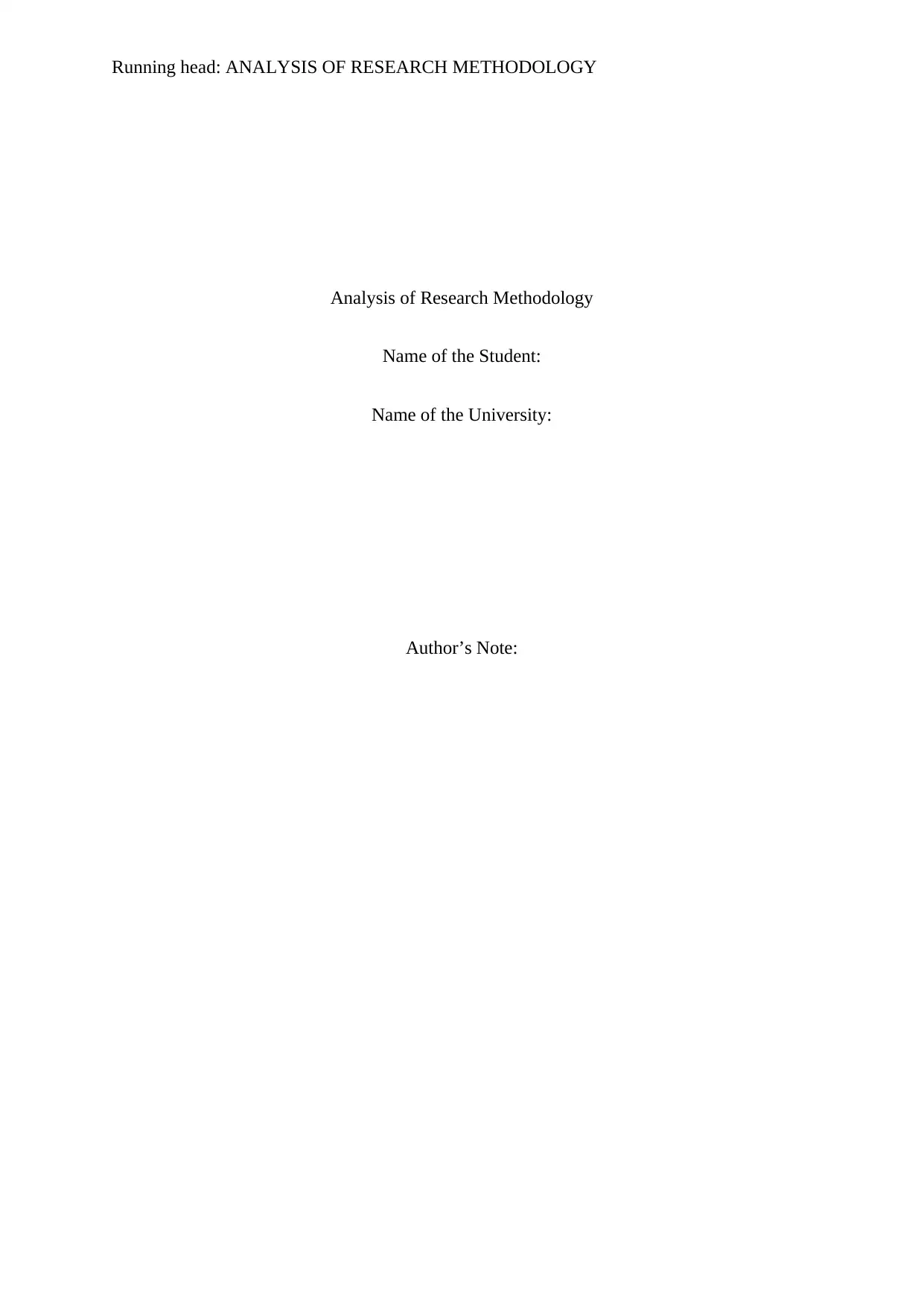
Running head: ANALYSIS OF RESEARCH METHODOLOGY
Analysis of Research Methodology
Name of the Student:
Name of the University:
Author’s Note:
Analysis of Research Methodology
Name of the Student:
Name of the University:
Author’s Note:
Paraphrase This Document
Need a fresh take? Get an instant paraphrase of this document with our AI Paraphraser
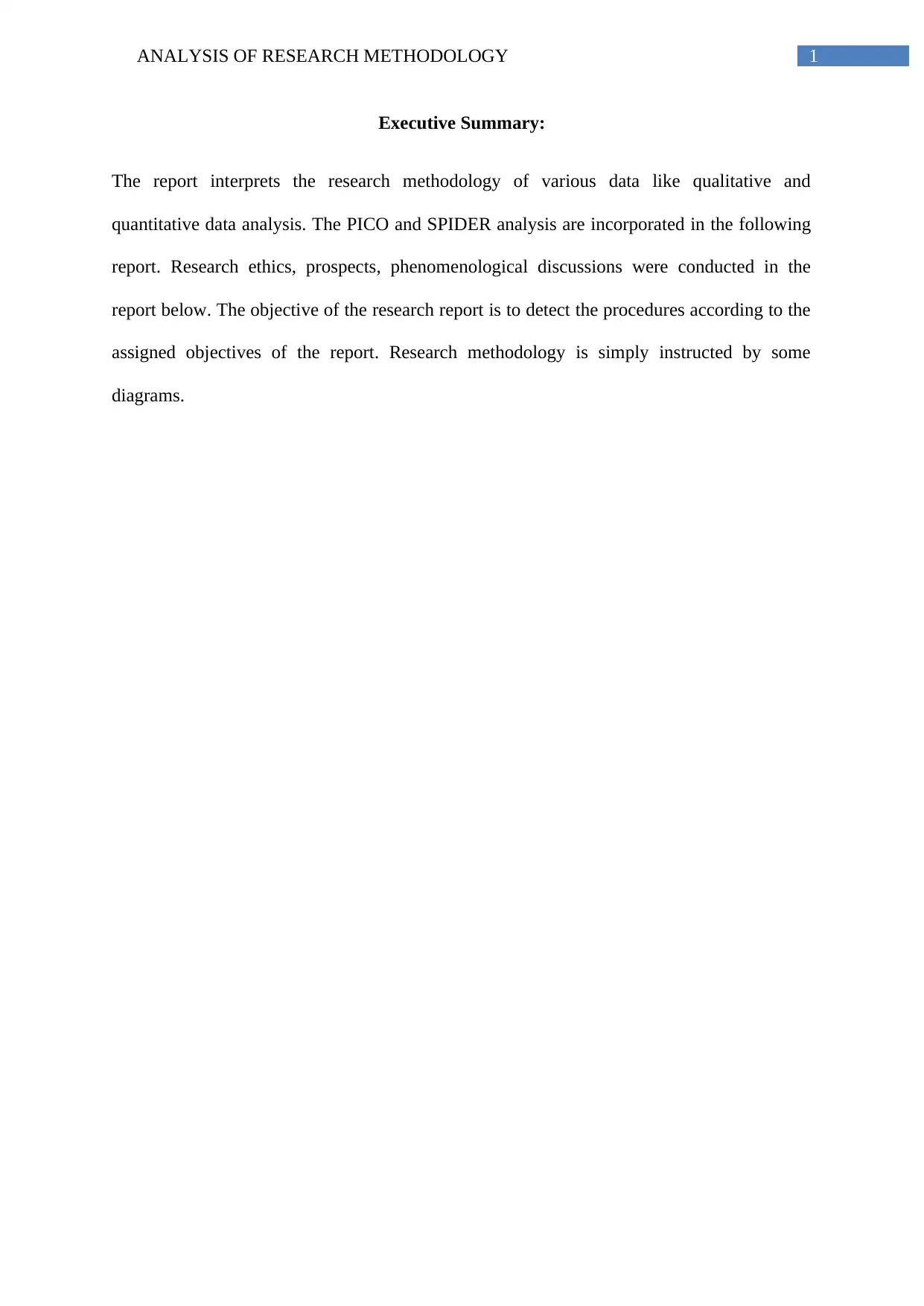
ANALYSIS OF RESEARCH METHODOLOGY 1
Executive Summary:
The report interprets the research methodology of various data like qualitative and
quantitative data analysis. The PICO and SPIDER analysis are incorporated in the following
report. Research ethics, prospects, phenomenological discussions were conducted in the
report below. The objective of the research report is to detect the procedures according to the
assigned objectives of the report. Research methodology is simply instructed by some
diagrams.
Executive Summary:
The report interprets the research methodology of various data like qualitative and
quantitative data analysis. The PICO and SPIDER analysis are incorporated in the following
report. Research ethics, prospects, phenomenological discussions were conducted in the
report below. The objective of the research report is to detect the procedures according to the
assigned objectives of the report. Research methodology is simply instructed by some
diagrams.
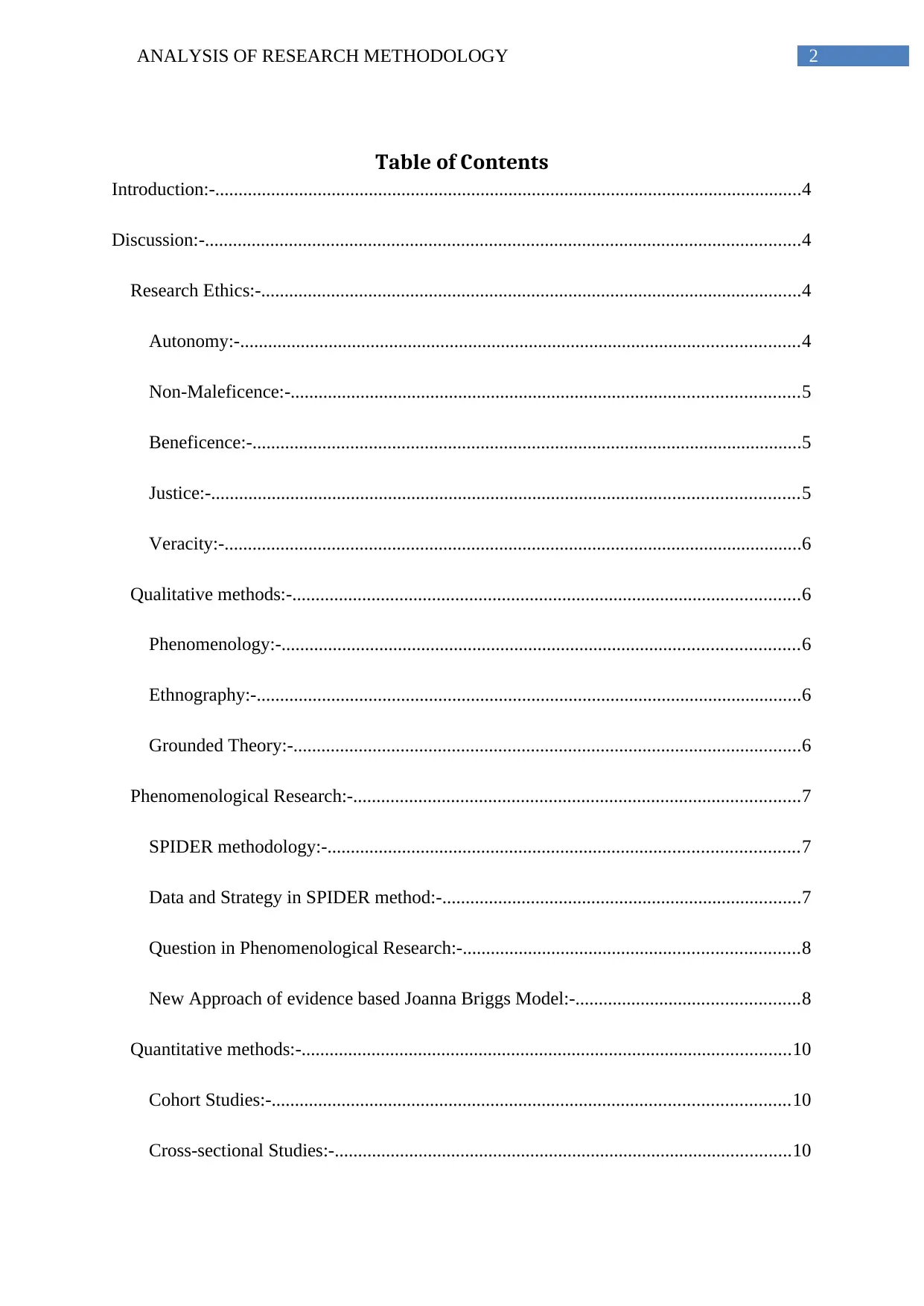
ANALYSIS OF RESEARCH METHODOLOGY 2
Table of Contents
Introduction:-..............................................................................................................................4
Discussion:-................................................................................................................................4
Research Ethics:-....................................................................................................................4
Autonomy:-........................................................................................................................4
Non-Maleficence:-.............................................................................................................5
Beneficence:-......................................................................................................................5
Justice:-..............................................................................................................................5
Veracity:-............................................................................................................................6
Qualitative methods:-.............................................................................................................6
Phenomenology:-...............................................................................................................6
Ethnography:-.....................................................................................................................6
Grounded Theory:-.............................................................................................................6
Phenomenological Research:-................................................................................................7
SPIDER methodology:-.....................................................................................................7
Data and Strategy in SPIDER method:-.............................................................................7
Question in Phenomenological Research:-........................................................................8
New Approach of evidence based Joanna Briggs Model:-................................................8
Quantitative methods:-.........................................................................................................10
Cohort Studies:-...............................................................................................................10
Cross-sectional Studies:-..................................................................................................10
Table of Contents
Introduction:-..............................................................................................................................4
Discussion:-................................................................................................................................4
Research Ethics:-....................................................................................................................4
Autonomy:-........................................................................................................................4
Non-Maleficence:-.............................................................................................................5
Beneficence:-......................................................................................................................5
Justice:-..............................................................................................................................5
Veracity:-............................................................................................................................6
Qualitative methods:-.............................................................................................................6
Phenomenology:-...............................................................................................................6
Ethnography:-.....................................................................................................................6
Grounded Theory:-.............................................................................................................6
Phenomenological Research:-................................................................................................7
SPIDER methodology:-.....................................................................................................7
Data and Strategy in SPIDER method:-.............................................................................7
Question in Phenomenological Research:-........................................................................8
New Approach of evidence based Joanna Briggs Model:-................................................8
Quantitative methods:-.........................................................................................................10
Cohort Studies:-...............................................................................................................10
Cross-sectional Studies:-..................................................................................................10
⊘ This is a preview!⊘
Do you want full access?
Subscribe today to unlock all pages.

Trusted by 1+ million students worldwide
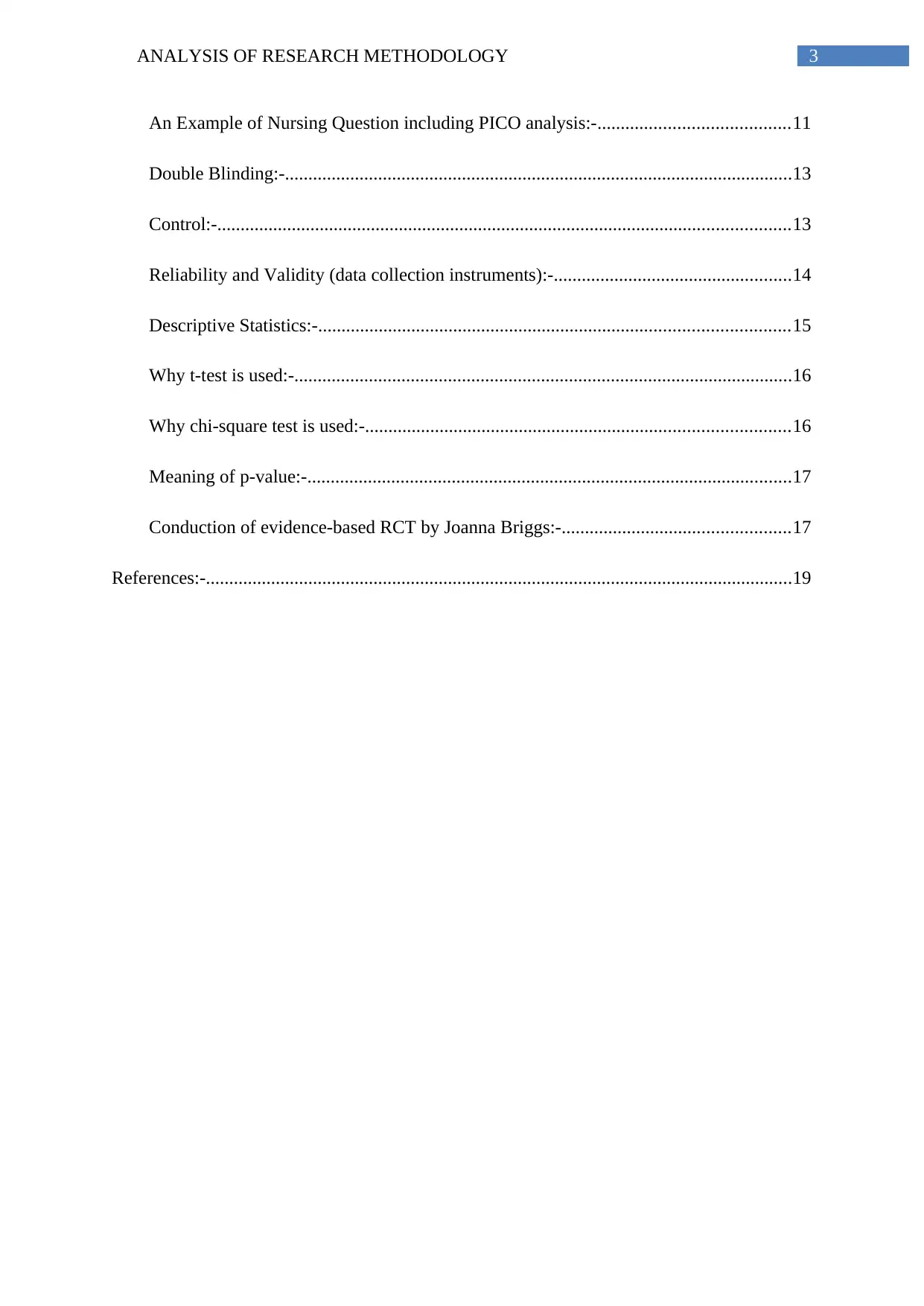
ANALYSIS OF RESEARCH METHODOLOGY 3
An Example of Nursing Question including PICO analysis:-.........................................11
Double Blinding:-.............................................................................................................13
Control:-...........................................................................................................................13
Reliability and Validity (data collection instruments):-...................................................14
Descriptive Statistics:-.....................................................................................................15
Why t-test is used:-...........................................................................................................16
Why chi-square test is used:-...........................................................................................16
Meaning of p-value:-........................................................................................................17
Conduction of evidence-based RCT by Joanna Briggs:-.................................................17
References:-..............................................................................................................................19
An Example of Nursing Question including PICO analysis:-.........................................11
Double Blinding:-.............................................................................................................13
Control:-...........................................................................................................................13
Reliability and Validity (data collection instruments):-...................................................14
Descriptive Statistics:-.....................................................................................................15
Why t-test is used:-...........................................................................................................16
Why chi-square test is used:-...........................................................................................16
Meaning of p-value:-........................................................................................................17
Conduction of evidence-based RCT by Joanna Briggs:-.................................................17
References:-..............................................................................................................................19
Paraphrase This Document
Need a fresh take? Get an instant paraphrase of this document with our AI Paraphraser
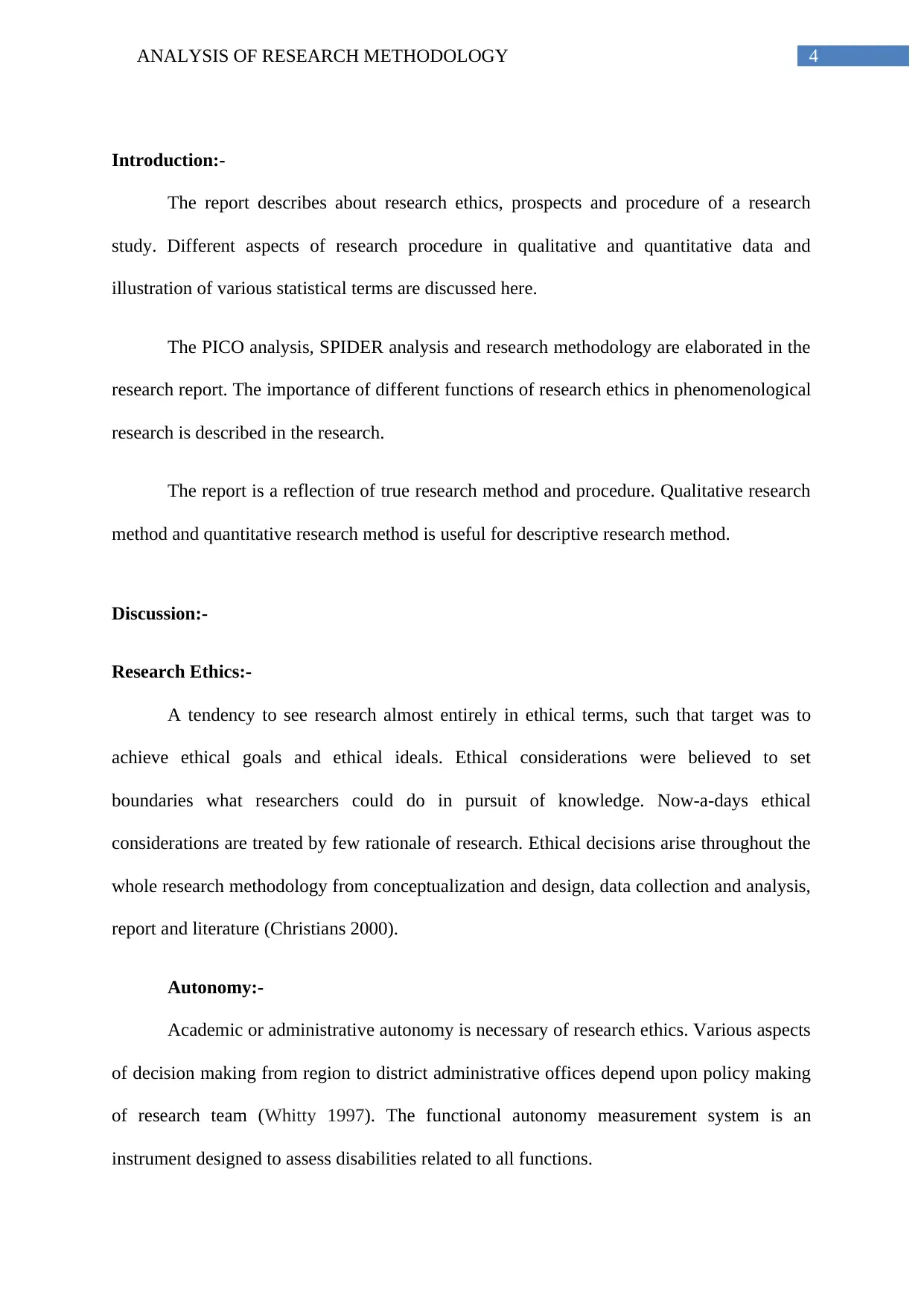
ANALYSIS OF RESEARCH METHODOLOGY 4
Introduction:-
The report describes about research ethics, prospects and procedure of a research
study. Different aspects of research procedure in qualitative and quantitative data and
illustration of various statistical terms are discussed here.
The PICO analysis, SPIDER analysis and research methodology are elaborated in the
research report. The importance of different functions of research ethics in phenomenological
research is described in the research.
The report is a reflection of true research method and procedure. Qualitative research
method and quantitative research method is useful for descriptive research method.
Discussion:-
Research Ethics:-
A tendency to see research almost entirely in ethical terms, such that target was to
achieve ethical goals and ethical ideals. Ethical considerations were believed to set
boundaries what researchers could do in pursuit of knowledge. Now-a-days ethical
considerations are treated by few rationale of research. Ethical decisions arise throughout the
whole research methodology from conceptualization and design, data collection and analysis,
report and literature (Christians 2000).
Autonomy:-
Academic or administrative autonomy is necessary of research ethics. Various aspects
of decision making from region to district administrative offices depend upon policy making
of research team (Whitty 1997). The functional autonomy measurement system is an
instrument designed to assess disabilities related to all functions.
Introduction:-
The report describes about research ethics, prospects and procedure of a research
study. Different aspects of research procedure in qualitative and quantitative data and
illustration of various statistical terms are discussed here.
The PICO analysis, SPIDER analysis and research methodology are elaborated in the
research report. The importance of different functions of research ethics in phenomenological
research is described in the research.
The report is a reflection of true research method and procedure. Qualitative research
method and quantitative research method is useful for descriptive research method.
Discussion:-
Research Ethics:-
A tendency to see research almost entirely in ethical terms, such that target was to
achieve ethical goals and ethical ideals. Ethical considerations were believed to set
boundaries what researchers could do in pursuit of knowledge. Now-a-days ethical
considerations are treated by few rationale of research. Ethical decisions arise throughout the
whole research methodology from conceptualization and design, data collection and analysis,
report and literature (Christians 2000).
Autonomy:-
Academic or administrative autonomy is necessary of research ethics. Various aspects
of decision making from region to district administrative offices depend upon policy making
of research team (Whitty 1997). The functional autonomy measurement system is an
instrument designed to assess disabilities related to all functions.
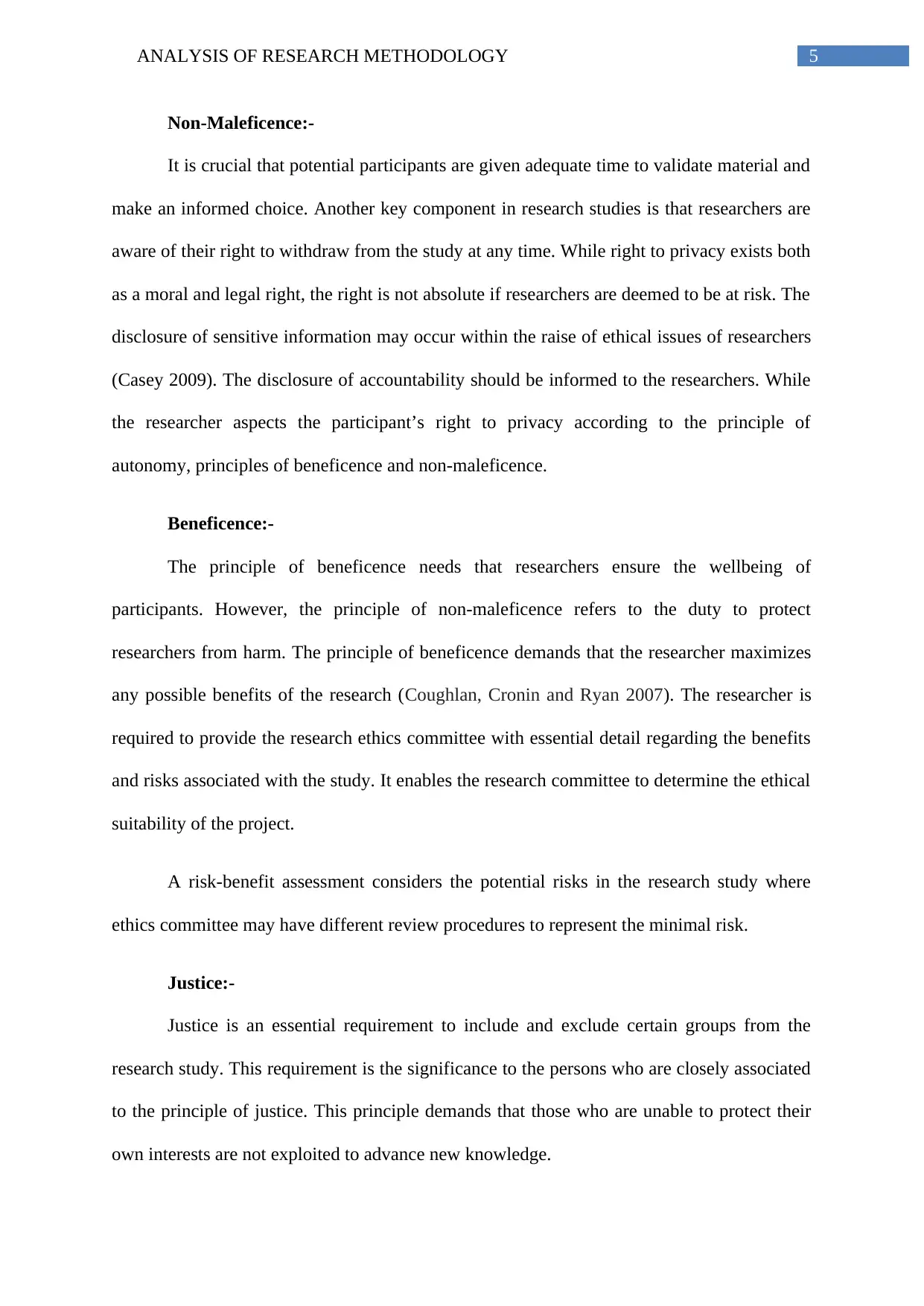
ANALYSIS OF RESEARCH METHODOLOGY 5
Non-Maleficence:-
It is crucial that potential participants are given adequate time to validate material and
make an informed choice. Another key component in research studies is that researchers are
aware of their right to withdraw from the study at any time. While right to privacy exists both
as a moral and legal right, the right is not absolute if researchers are deemed to be at risk. The
disclosure of sensitive information may occur within the raise of ethical issues of researchers
(Casey 2009). The disclosure of accountability should be informed to the researchers. While
the researcher aspects the participant’s right to privacy according to the principle of
autonomy, principles of beneficence and non-maleficence.
Beneficence:-
The principle of beneficence needs that researchers ensure the wellbeing of
participants. However, the principle of non-maleficence refers to the duty to protect
researchers from harm. The principle of beneficence demands that the researcher maximizes
any possible benefits of the research (Coughlan, Cronin and Ryan 2007). The researcher is
required to provide the research ethics committee with essential detail regarding the benefits
and risks associated with the study. It enables the research committee to determine the ethical
suitability of the project.
A risk-benefit assessment considers the potential risks in the research study where
ethics committee may have different review procedures to represent the minimal risk.
Justice:-
Justice is an essential requirement to include and exclude certain groups from the
research study. This requirement is the significance to the persons who are closely associated
to the principle of justice. This principle demands that those who are unable to protect their
own interests are not exploited to advance new knowledge.
Non-Maleficence:-
It is crucial that potential participants are given adequate time to validate material and
make an informed choice. Another key component in research studies is that researchers are
aware of their right to withdraw from the study at any time. While right to privacy exists both
as a moral and legal right, the right is not absolute if researchers are deemed to be at risk. The
disclosure of sensitive information may occur within the raise of ethical issues of researchers
(Casey 2009). The disclosure of accountability should be informed to the researchers. While
the researcher aspects the participant’s right to privacy according to the principle of
autonomy, principles of beneficence and non-maleficence.
Beneficence:-
The principle of beneficence needs that researchers ensure the wellbeing of
participants. However, the principle of non-maleficence refers to the duty to protect
researchers from harm. The principle of beneficence demands that the researcher maximizes
any possible benefits of the research (Coughlan, Cronin and Ryan 2007). The researcher is
required to provide the research ethics committee with essential detail regarding the benefits
and risks associated with the study. It enables the research committee to determine the ethical
suitability of the project.
A risk-benefit assessment considers the potential risks in the research study where
ethics committee may have different review procedures to represent the minimal risk.
Justice:-
Justice is an essential requirement to include and exclude certain groups from the
research study. This requirement is the significance to the persons who are closely associated
to the principle of justice. This principle demands that those who are unable to protect their
own interests are not exploited to advance new knowledge.
⊘ This is a preview!⊘
Do you want full access?
Subscribe today to unlock all pages.

Trusted by 1+ million students worldwide
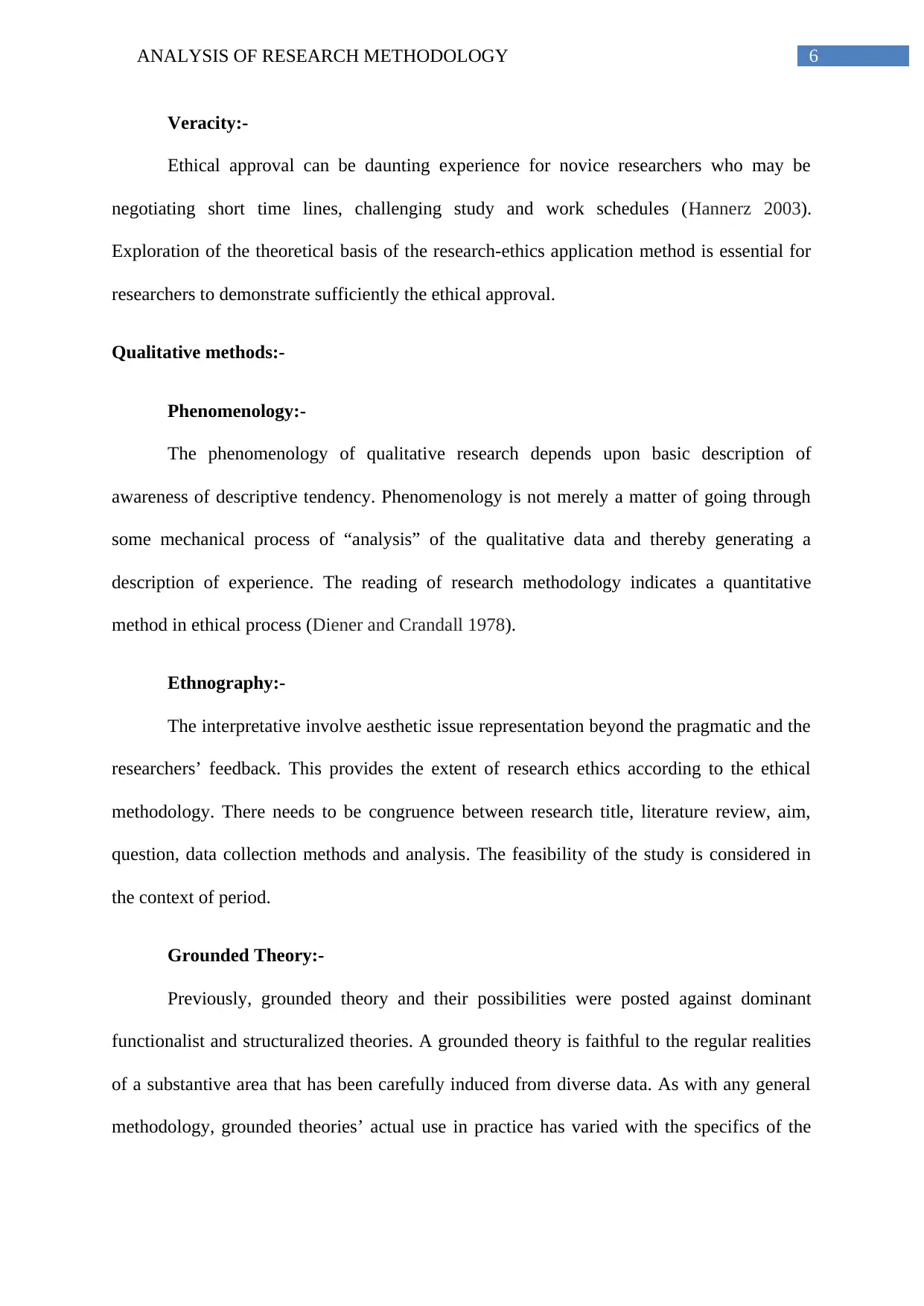
ANALYSIS OF RESEARCH METHODOLOGY 6
Veracity:-
Ethical approval can be daunting experience for novice researchers who may be
negotiating short time lines, challenging study and work schedules (Hannerz 2003).
Exploration of the theoretical basis of the research-ethics application method is essential for
researchers to demonstrate sufficiently the ethical approval.
Qualitative methods:-
Phenomenology:-
The phenomenology of qualitative research depends upon basic description of
awareness of descriptive tendency. Phenomenology is not merely a matter of going through
some mechanical process of “analysis” of the qualitative data and thereby generating a
description of experience. The reading of research methodology indicates a quantitative
method in ethical process (Diener and Crandall 1978).
Ethnography:-
The interpretative involve aesthetic issue representation beyond the pragmatic and the
researchers’ feedback. This provides the extent of research ethics according to the ethical
methodology. There needs to be congruence between research title, literature review, aim,
question, data collection methods and analysis. The feasibility of the study is considered in
the context of period.
Grounded Theory:-
Previously, grounded theory and their possibilities were posted against dominant
functionalist and structuralized theories. A grounded theory is faithful to the regular realities
of a substantive area that has been carefully induced from diverse data. As with any general
methodology, grounded theories’ actual use in practice has varied with the specifics of the
Veracity:-
Ethical approval can be daunting experience for novice researchers who may be
negotiating short time lines, challenging study and work schedules (Hannerz 2003).
Exploration of the theoretical basis of the research-ethics application method is essential for
researchers to demonstrate sufficiently the ethical approval.
Qualitative methods:-
Phenomenology:-
The phenomenology of qualitative research depends upon basic description of
awareness of descriptive tendency. Phenomenology is not merely a matter of going through
some mechanical process of “analysis” of the qualitative data and thereby generating a
description of experience. The reading of research methodology indicates a quantitative
method in ethical process (Diener and Crandall 1978).
Ethnography:-
The interpretative involve aesthetic issue representation beyond the pragmatic and the
researchers’ feedback. This provides the extent of research ethics according to the ethical
methodology. There needs to be congruence between research title, literature review, aim,
question, data collection methods and analysis. The feasibility of the study is considered in
the context of period.
Grounded Theory:-
Previously, grounded theory and their possibilities were posted against dominant
functionalist and structuralized theories. A grounded theory is faithful to the regular realities
of a substantive area that has been carefully induced from diverse data. As with any general
methodology, grounded theories’ actual use in practice has varied with the specifics of the
Paraphrase This Document
Need a fresh take? Get an instant paraphrase of this document with our AI Paraphraser
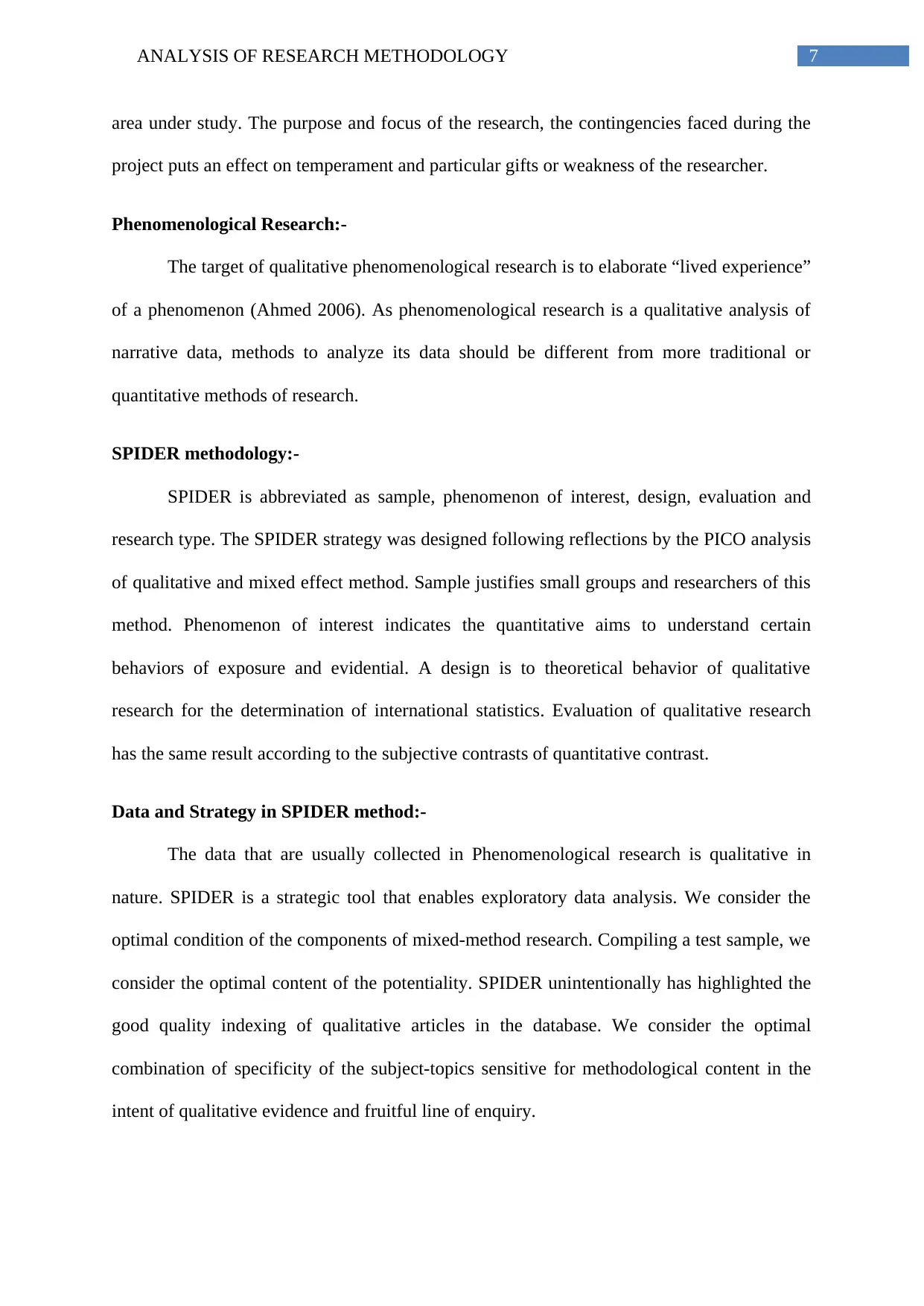
ANALYSIS OF RESEARCH METHODOLOGY 7
area under study. The purpose and focus of the research, the contingencies faced during the
project puts an effect on temperament and particular gifts or weakness of the researcher.
Phenomenological Research:-
The target of qualitative phenomenological research is to elaborate “lived experience”
of a phenomenon (Ahmed 2006). As phenomenological research is a qualitative analysis of
narrative data, methods to analyze its data should be different from more traditional or
quantitative methods of research.
SPIDER methodology:-
SPIDER is abbreviated as sample, phenomenon of interest, design, evaluation and
research type. The SPIDER strategy was designed following reflections by the PICO analysis
of qualitative and mixed effect method. Sample justifies small groups and researchers of this
method. Phenomenon of interest indicates the quantitative aims to understand certain
behaviors of exposure and evidential. A design is to theoretical behavior of qualitative
research for the determination of international statistics. Evaluation of qualitative research
has the same result according to the subjective contrasts of quantitative contrast.
Data and Strategy in SPIDER method:-
The data that are usually collected in Phenomenological research is qualitative in
nature. SPIDER is a strategic tool that enables exploratory data analysis. We consider the
optimal condition of the components of mixed-method research. Compiling a test sample, we
consider the optimal content of the potentiality. SPIDER unintentionally has highlighted the
good quality indexing of qualitative articles in the database. We consider the optimal
combination of specificity of the subject-topics sensitive for methodological content in the
intent of qualitative evidence and fruitful line of enquiry.
area under study. The purpose and focus of the research, the contingencies faced during the
project puts an effect on temperament and particular gifts or weakness of the researcher.
Phenomenological Research:-
The target of qualitative phenomenological research is to elaborate “lived experience”
of a phenomenon (Ahmed 2006). As phenomenological research is a qualitative analysis of
narrative data, methods to analyze its data should be different from more traditional or
quantitative methods of research.
SPIDER methodology:-
SPIDER is abbreviated as sample, phenomenon of interest, design, evaluation and
research type. The SPIDER strategy was designed following reflections by the PICO analysis
of qualitative and mixed effect method. Sample justifies small groups and researchers of this
method. Phenomenon of interest indicates the quantitative aims to understand certain
behaviors of exposure and evidential. A design is to theoretical behavior of qualitative
research for the determination of international statistics. Evaluation of qualitative research
has the same result according to the subjective contrasts of quantitative contrast.
Data and Strategy in SPIDER method:-
The data that are usually collected in Phenomenological research is qualitative in
nature. SPIDER is a strategic tool that enables exploratory data analysis. We consider the
optimal condition of the components of mixed-method research. Compiling a test sample, we
consider the optimal content of the potentiality. SPIDER unintentionally has highlighted the
good quality indexing of qualitative articles in the database. We consider the optimal
combination of specificity of the subject-topics sensitive for methodological content in the
intent of qualitative evidence and fruitful line of enquiry.
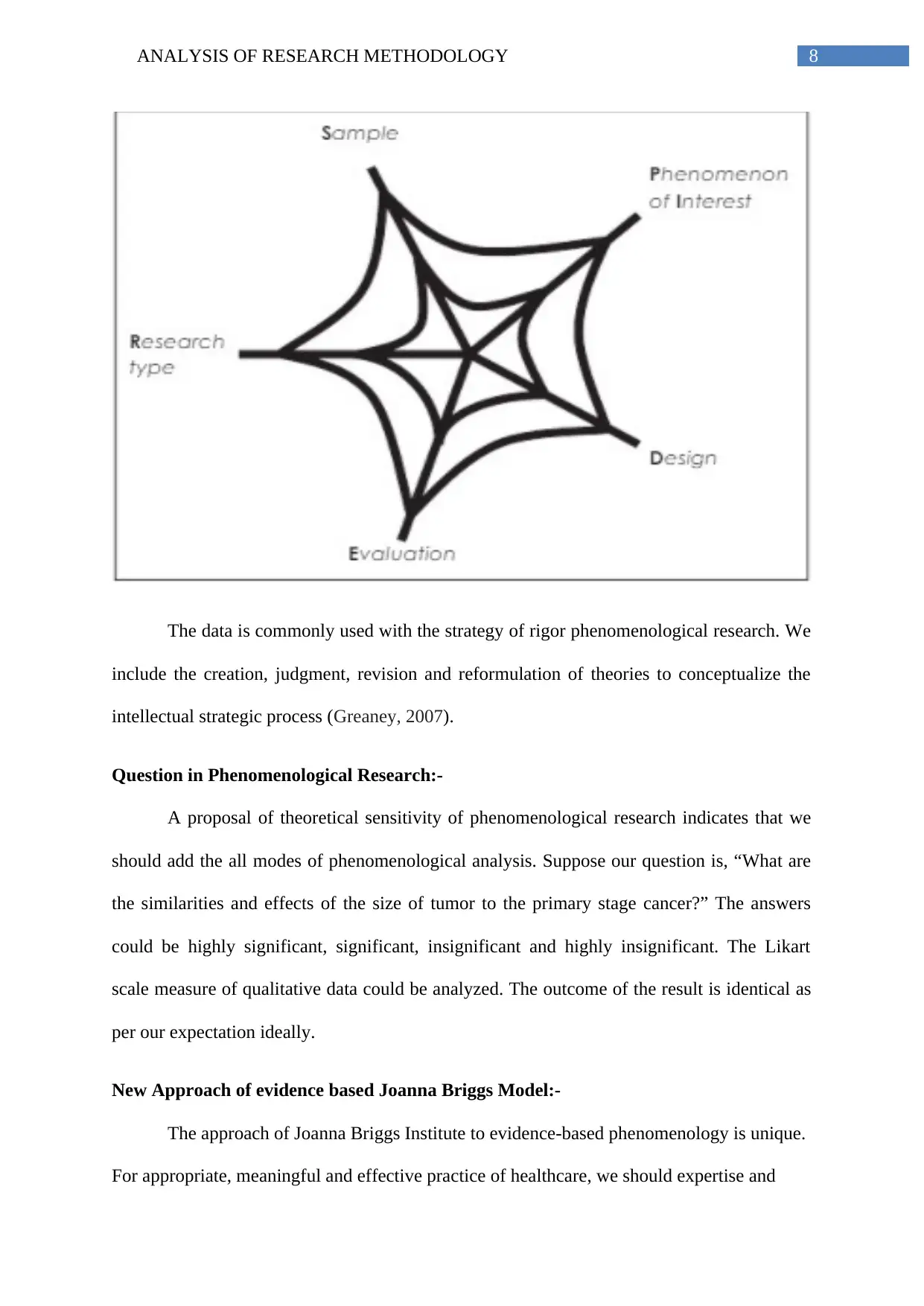
ANALYSIS OF RESEARCH METHODOLOGY 8
The data is commonly used with the strategy of rigor phenomenological research. We
include the creation, judgment, revision and reformulation of theories to conceptualize the
intellectual strategic process (Greaney, 2007).
Question in Phenomenological Research:-
A proposal of theoretical sensitivity of phenomenological research indicates that we
should add the all modes of phenomenological analysis. Suppose our question is, “What are
the similarities and effects of the size of tumor to the primary stage cancer?” The answers
could be highly significant, significant, insignificant and highly insignificant. The Likart
scale measure of qualitative data could be analyzed. The outcome of the result is identical as
per our expectation ideally.
New Approach of evidence based Joanna Briggs Model:-
The approach of Joanna Briggs Institute to evidence-based phenomenology is unique.
For appropriate, meaningful and effective practice of healthcare, we should expertise and
The data is commonly used with the strategy of rigor phenomenological research. We
include the creation, judgment, revision and reformulation of theories to conceptualize the
intellectual strategic process (Greaney, 2007).
Question in Phenomenological Research:-
A proposal of theoretical sensitivity of phenomenological research indicates that we
should add the all modes of phenomenological analysis. Suppose our question is, “What are
the similarities and effects of the size of tumor to the primary stage cancer?” The answers
could be highly significant, significant, insignificant and highly insignificant. The Likart
scale measure of qualitative data could be analyzed. The outcome of the result is identical as
per our expectation ideally.
New Approach of evidence based Joanna Briggs Model:-
The approach of Joanna Briggs Institute to evidence-based phenomenology is unique.
For appropriate, meaningful and effective practice of healthcare, we should expertise and
⊘ This is a preview!⊘
Do you want full access?
Subscribe today to unlock all pages.

Trusted by 1+ million students worldwide
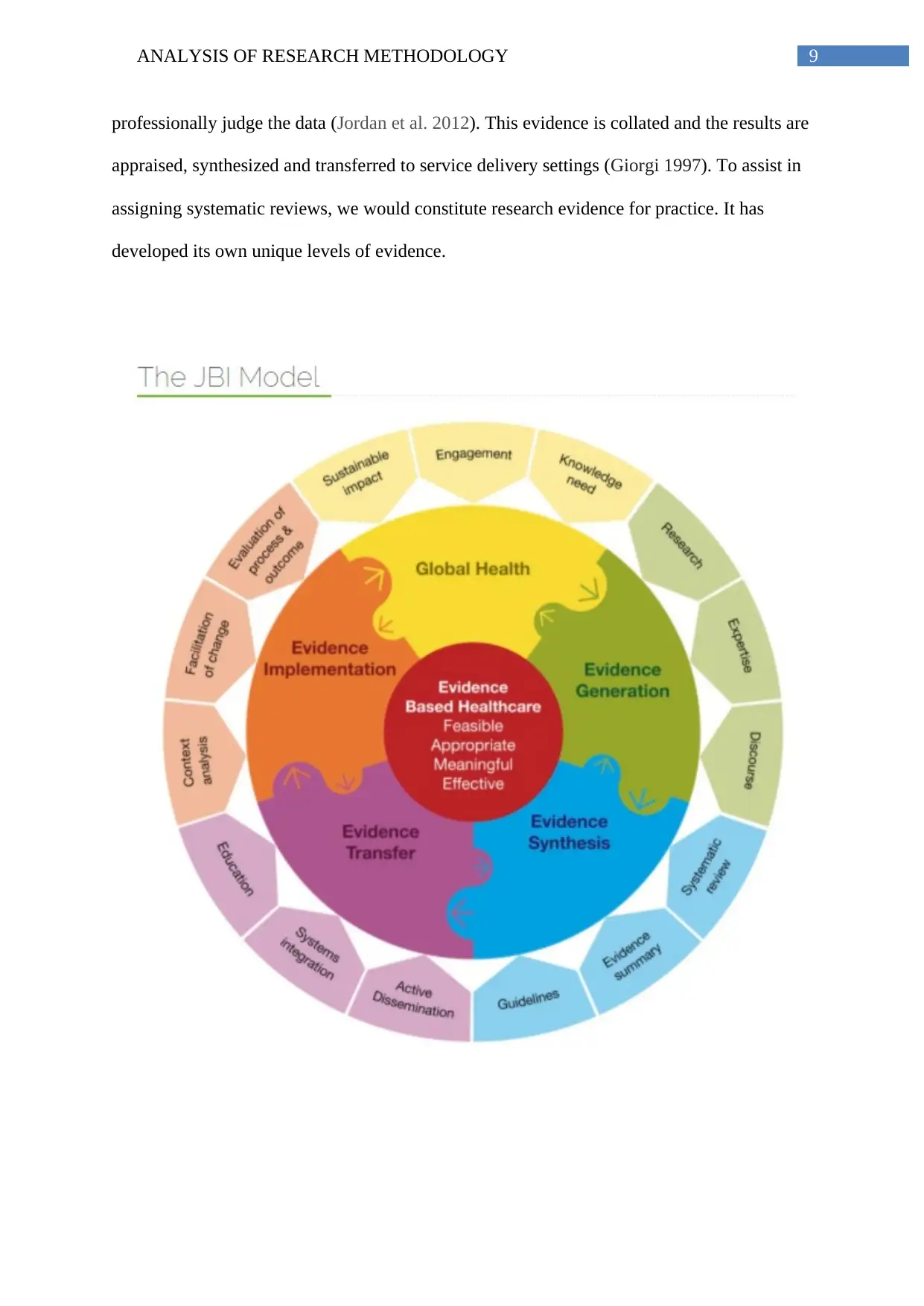
ANALYSIS OF RESEARCH METHODOLOGY 9
professionally judge the data (Jordan et al. 2012). This evidence is collated and the results are
appraised, synthesized and transferred to service delivery settings (Giorgi 1997). To assist in
assigning systematic reviews, we would constitute research evidence for practice. It has
developed its own unique levels of evidence.
professionally judge the data (Jordan et al. 2012). This evidence is collated and the results are
appraised, synthesized and transferred to service delivery settings (Giorgi 1997). To assist in
assigning systematic reviews, we would constitute research evidence for practice. It has
developed its own unique levels of evidence.
Paraphrase This Document
Need a fresh take? Get an instant paraphrase of this document with our AI Paraphraser
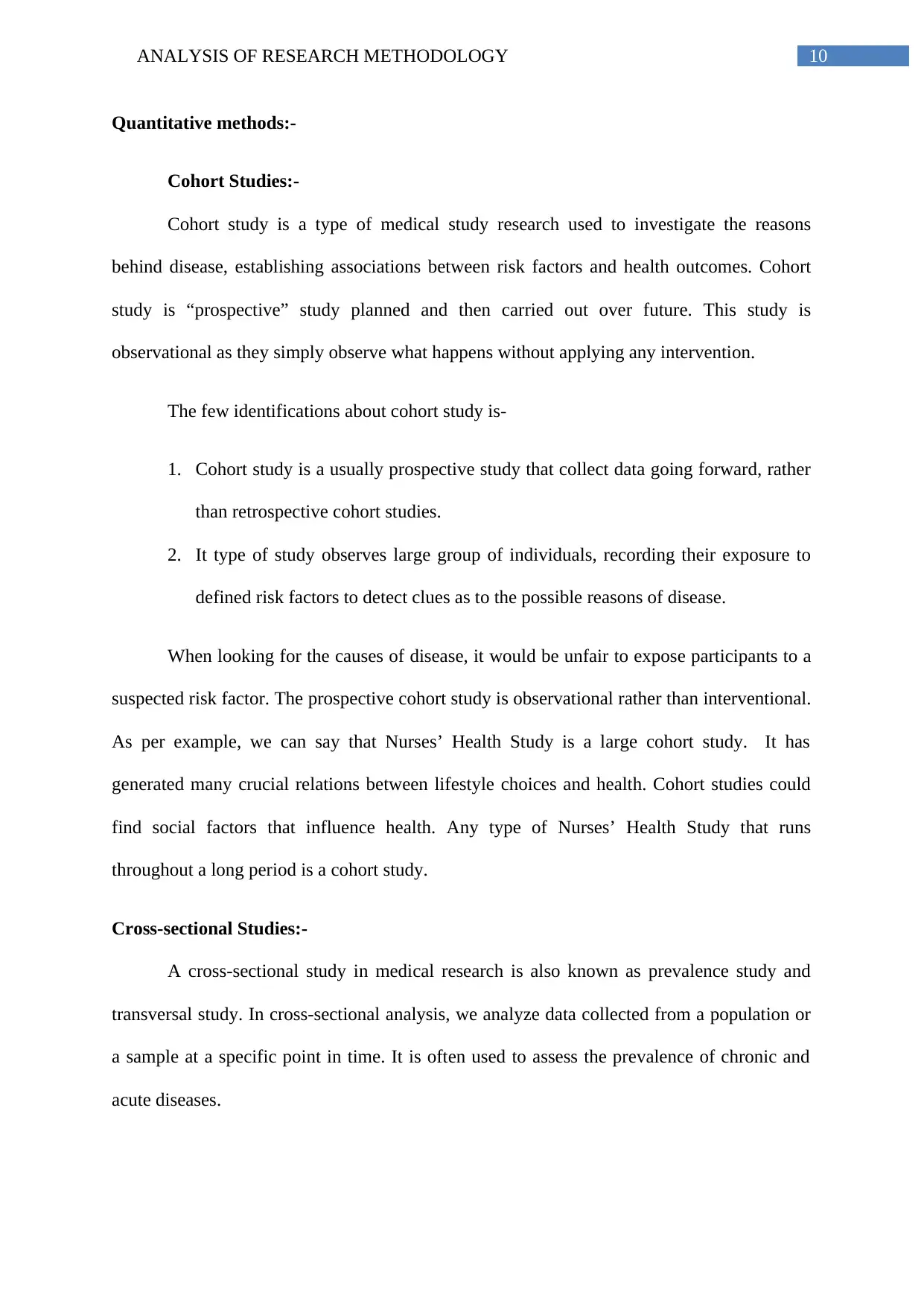
ANALYSIS OF RESEARCH METHODOLOGY 10
Quantitative methods:-
Cohort Studies:-
Cohort study is a type of medical study research used to investigate the reasons
behind disease, establishing associations between risk factors and health outcomes. Cohort
study is “prospective” study planned and then carried out over future. This study is
observational as they simply observe what happens without applying any intervention.
The few identifications about cohort study is-
1. Cohort study is a usually prospective study that collect data going forward, rather
than retrospective cohort studies.
2. It type of study observes large group of individuals, recording their exposure to
defined risk factors to detect clues as to the possible reasons of disease.
When looking for the causes of disease, it would be unfair to expose participants to a
suspected risk factor. The prospective cohort study is observational rather than interventional.
As per example, we can say that Nurses’ Health Study is a large cohort study. It has
generated many crucial relations between lifestyle choices and health. Cohort studies could
find social factors that influence health. Any type of Nurses’ Health Study that runs
throughout a long period is a cohort study.
Cross-sectional Studies:-
A cross-sectional study in medical research is also known as prevalence study and
transversal study. In cross-sectional analysis, we analyze data collected from a population or
a sample at a specific point in time. It is often used to assess the prevalence of chronic and
acute diseases.
Quantitative methods:-
Cohort Studies:-
Cohort study is a type of medical study research used to investigate the reasons
behind disease, establishing associations between risk factors and health outcomes. Cohort
study is “prospective” study planned and then carried out over future. This study is
observational as they simply observe what happens without applying any intervention.
The few identifications about cohort study is-
1. Cohort study is a usually prospective study that collect data going forward, rather
than retrospective cohort studies.
2. It type of study observes large group of individuals, recording their exposure to
defined risk factors to detect clues as to the possible reasons of disease.
When looking for the causes of disease, it would be unfair to expose participants to a
suspected risk factor. The prospective cohort study is observational rather than interventional.
As per example, we can say that Nurses’ Health Study is a large cohort study. It has
generated many crucial relations between lifestyle choices and health. Cohort studies could
find social factors that influence health. Any type of Nurses’ Health Study that runs
throughout a long period is a cohort study.
Cross-sectional Studies:-
A cross-sectional study in medical research is also known as prevalence study and
transversal study. In cross-sectional analysis, we analyze data collected from a population or
a sample at a specific point in time. It is often used to assess the prevalence of chronic and
acute diseases.
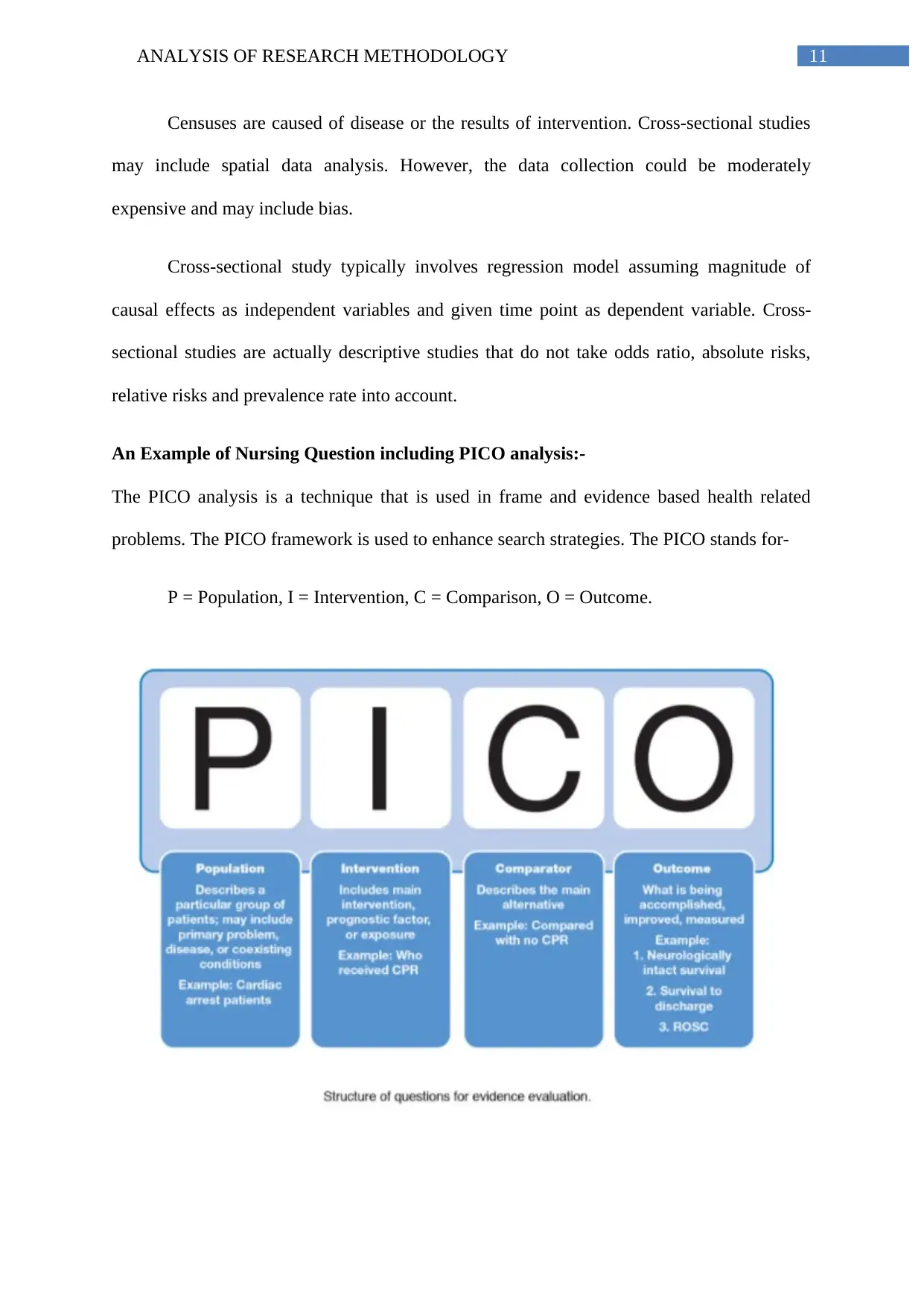
ANALYSIS OF RESEARCH METHODOLOGY 11
Censuses are caused of disease or the results of intervention. Cross-sectional studies
may include spatial data analysis. However, the data collection could be moderately
expensive and may include bias.
Cross-sectional study typically involves regression model assuming magnitude of
causal effects as independent variables and given time point as dependent variable. Cross-
sectional studies are actually descriptive studies that do not take odds ratio, absolute risks,
relative risks and prevalence rate into account.
An Example of Nursing Question including PICO analysis:-
The PICO analysis is a technique that is used in frame and evidence based health related
problems. The PICO framework is used to enhance search strategies. The PICO stands for-
P = Population, I = Intervention, C = Comparison, O = Outcome.
Censuses are caused of disease or the results of intervention. Cross-sectional studies
may include spatial data analysis. However, the data collection could be moderately
expensive and may include bias.
Cross-sectional study typically involves regression model assuming magnitude of
causal effects as independent variables and given time point as dependent variable. Cross-
sectional studies are actually descriptive studies that do not take odds ratio, absolute risks,
relative risks and prevalence rate into account.
An Example of Nursing Question including PICO analysis:-
The PICO analysis is a technique that is used in frame and evidence based health related
problems. The PICO framework is used to enhance search strategies. The PICO stands for-
P = Population, I = Intervention, C = Comparison, O = Outcome.
⊘ This is a preview!⊘
Do you want full access?
Subscribe today to unlock all pages.

Trusted by 1+ million students worldwide
1 out of 21
Related Documents
Your All-in-One AI-Powered Toolkit for Academic Success.
+13062052269
info@desklib.com
Available 24*7 on WhatsApp / Email
![[object Object]](/_next/static/media/star-bottom.7253800d.svg)
Unlock your academic potential
Copyright © 2020–2025 A2Z Services. All Rights Reserved. Developed and managed by ZUCOL.





